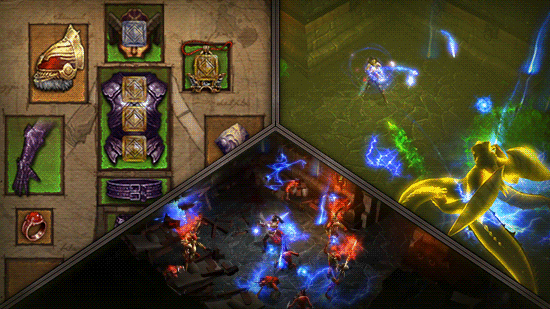Diablo 3 news » Developer Chronicles - Rift Fishing
Hi all, Joe Shely here.
I’d like to talk about our philosophy for the design changes we make that affect Greater Rifts and how we think about Rift “fishing.”
When you are pushing Greater Rifts (either to improve your highest Greater Rift rank or to increase your maximum Legendary Gem rank), you start to encounter situations where you’re selecting a Rift that you may not be able to complete.
Whether you can complete that Rift or not depends on three factors:
- Your character’s overall power, including how much main stat you have, your Critical Strike chance, etc. This is the largest factor and comes primarily from your gear.
- How well you execute your character’s build. For example, maximizing Focus and Restraint uptime, getting the most value out of each Convention of the Elements cycle, and so on.
- How well you adapt to the various challenges the dungeon throws at you. These include things like dungeon layout, number of branching paths, room size, enemy population type, and which Rift boss you encounter.
In other words, Greater Rifts require some combination of three things: Power, Execution, and Adaptability.

If we wanted to, we could make every Rift roll the same tile-set, layout, population, and boss. That would put all of the focus on execution. This can be fun in short bursts, and in fact Challenge Rifts do exactly this at a fixed power level. Each time a new Challenge Rift is introduced you’ll be presented with a new character and build to try. We plan to introduce new Challenge Rifts frequently to keep the experience fresh.
Greater Rifts are a different beast.
You spend a lot of time with the same character. That character’s power level doesn’t change very fast, especially in the late game when you’re running with a complete set of well-rolled items. And your execution—the buttons you’re pressing—doesn’t change very often. You improve over time and might try a new build, but overall this value is fairly static…so we need to look elsewhere to keep Greater Rifts fun to play again and again.
This is where adaptability comes in. We design monsters, Rift Guardians, affixes, and dungeon layouts that throw a wide variety of challenges at you—within reason.
Your experience should vary from one Rift to the next, but if it varies too much, it feels like whether you can complete a Rift is entirely out of your control. Our target with Rift changes has been to reduce that variation while keeping the play experience different from Rift to Rift.

If you step into a Rift and see that the first floor is a cave, or the first population has a lot of Writhing Deceivers and you instantly know that Rift will be impossible to complete, then the cave tile-set or the monster probably needs tweaking.
Along these lines, we reduced the average size of a Rift floor in Patch 2.4.3 to increase the number of floors you see in a given Rift, placing less emphasis on the tile-set or population of a given floor. We also made improvements where a specific monster or tile-set was out of line, like fixing big empty areas in the Heaven tile-set or making Writhing Deceivers emerge more quickly from hiding.
Now, when you’re pushing the absolute limit of your character’s power and execution, there will inevitably come a point where you can only succeed if you get that perfect Rift. That’s a reality we aren’t trying to circumvent. But by setting the right balance between character power, execution, and adaptability in Greater Rifts, we can broadly improve the experience and raise the threshold at which everything has to go perfectly.















 Update comments
Update comments